Read the full story on the SGI news feed… here
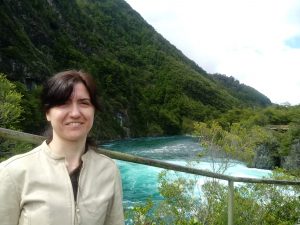
We recently interviewed Dr Sara Giarola, Research Fellow at the Sustainable Gas Institute and the lead modeller for the energy systems model, MUSE. We asked her about how policymakers in governments are using MUSE and other models to inform their decision making for COP-26.
It was the Oil crisis in the 1970s that prompted the development of tools which described the links between energy supply, demand, and their impact on the energy security of many nations in the world. These tools were the first known energy system models.
An energy system model is a mathematical representation of the sources of energy (e.g. renewables and fossil fuels), the destinations for energy (or “end-uses”, which include all the diverse needs of energy of our society, from the electricity consumed in our houses to the electricity used to run electric vehicles), and all the possible ways with which energy can transform from one to another form. For example, wind power can be converted into electricity in wind farms and distributed to our households.
Energy system models can be quite diverse. However, their communal strength relies in combining energy technologies, with environmental (for example, the interactions between energy and climate) and societal factors, and different policies. This makes them privileged tools to evaluate the implications of climate policies and industrial strategies.
Being a chemical engineer, I have always been fascinated by mathematics, especially when used to describe phenomena occurring at any scale, from chemical reactions to interconnected macro-systems. Since my PhD, which was on the optimisation of biofuels in transport, I became interested in energy problems and made energy system modelling one of my main research interests.
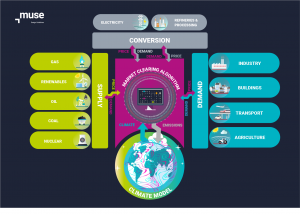
MUSE (ModUlar energy system Simulation Environment) models all the possible ways in which energy can be transformed on a global scale. It differs from existing models in many ways, but the agent-based nature of the model is particularly important. Models attempt to capture the behaviour of individuals within an environment. MUSE has an accurate description of the investment and operational decisions made in each geographical region and sector.
MUSE, not only describes each energy sector model (e.g., natural gas or renewables) presenting a comprehensive picture of all technologies in the sector, but also captures the diversity of drivers. These drivers are what lead firms and consumers to buy a specific energy technology rather than another one, and build upon factors such as education level, wealth, principles, and socio-cultural context.
In compliance with the Paris Agreement, governments need to take fundamental decisions around their plans of actions for reducing the greenhouse emissions. Energy models can be used to run “what-if” analyses asking questions around the shape of the energy mix in the future. Many of applications will be published in an IPCC Assessment report to be published in 2022.
The upcoming UN Climate Change Conference of the Parties (COP26), will be a milestone review of current achievements and future targets in the decarbonisation process. One of the key questions which the world will have to face will be around securing a global net-zero target by 2050 while keeping the 1.5 degrees limit in temperature increase compared to pre-industrial time. In order to answer this question, the modelling community has been involved in an unprecedented effort to help provide evidence through model inter-comparison studies to help facilitate transparent and robust dialogue between stakeholders.
MUSE is part of the the Paris Reinforce project and of the Climate Compatible Growth (CCG) programme.
Paris Reinforce builds upon an extensive modelling ensemble comprising five national/regional models for Europe, nine national models for countries outside of Europe, and eight global models. The project focuses on assessing climate policy decision within structured frameworks created around model inter-comparison studies in view of reaching the Paris Agreement targets, building bolder ambitions from existing Nationally Determined Contributions (NDCs) and National Economic and Climate Plans (NECPs).
CCG is a UK-research programme developed in preparation for COP26 to support investment in sustainable energy. Among the many research outputs, CCG analysts have produced a multi-model comparison study where four global energy system models and selected power sector models, were used to investigate the timing and rate of the global coal phase out, which is essential to foster a Paris Agreement-complaint energy system.
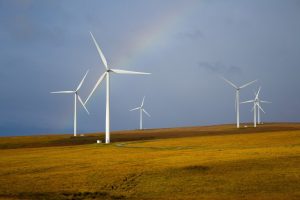
One of the main difficulties of the energy system models, is to translate into research questions stakeholders’ concerns: workshops and surveys are important to identify their priorities. Similarly, translating the research finding into a message to policymakers and stakeholders could also be challenging, as models always bear a certain level of approximation of the real-world phenomena due to their inherent mathematical description.
It is interesting to see where major barriers to decarbonisation may lie. We recently modelled the real market segmentation of the ammonia industry in China, the biggest world ammonia manufacturer. As enterprises vary in size and governance, a net-zero transition becomes less favoured if specific policy mechanisms are absent to ensure competitivity. Therefore, in China, a net-zero ammonia industry would need to go beyond the unique implementation of a carbon tax and adopt more sophisticated subsidy schemes to allow the transition for enterprises with lower access to capital.
Information on the MUSE model can be found on the new Imperial College microsite, where you will see who is working on the model, our publications, and of stories from researchers sharing their views on the energy system transformations.
We will also launch our energy system simulator in the next month, where you can explore how the energy mix might evolve between now and 2100.
MUSE will soon be available as an open source software on a Github where you can copy the code, learn how the model works, and suggest ways to improve it, in a truly transparent global collaboration.
How to reduce emissions from industry?
By the time you finish your masters, you’ll know your thesis inside out. We challenged one of our researchers at the Sustainable Gas Institute to explain their research in a short one minute video as part of the ‘Research in a Nutshell Series’.
Sandro Luh is a visiting Masters student from the ETH Zurich. He is using the MUSE energy systems model to examine the potential of different strategies for reducing CO2 emissions in the industrial sector. This includes measures such as fuel switching, electrification and Carbon Capture & Storage.
The industrial sector is a key sector to decarbonise as it accounts for 24% of the total global CO2 emissions (2014).
If you want to find out more about Sandro’s work, read our short interview with him.
This short two-minute film features, Yingjian Guo, a PhD student at the Department of Chemical Engineering, at Imperial College.
Yingjian’s PhD is looking at exploring the role of natural gas transport and distribution infrastructure in Future Low Carbon Energy Systems.
In this short film (a series of three student films), Yingjian describes her motivations for working in the area of energy and climate change.
She also talks about working on the natural gas module of the MUSE (Modular Universal energy system Simulation Environment), which is a new model that SGI is developing to analyse energy systems at a global level.
A beta version of the MUSE energy systems model will be available in July 2016 . If you want to find out more about the model, please read our MUSE page.
Last week, Arnaud Koehl, a PhD researcher at the Department of Primary Care and Public Health at Imperial College, attended the United Nations Conference of the Parties COP22 climate conference in Marrakech. Arnaud is investigating the kind of sustainable transport policies that could co-benefit health and the economy while addressing climate change.
The transport sector represents about 14% of worldwide greenhouse gases emissions (Intergovernmental Panel on Climate Change IPCC, 2010). More worryingly, the International Energy Agency (IEA) projects a huge growth in private motorised modes of transport; according to these estimates, there will be around 2 billion cars on the roads by 2040! It is therefore paramount that we find low-carbon pathways that will meet the increasing demand for mobility.
So how will these transport emissions (addressed by the Paris Agreement) be enforced by 2020? The way the Agreement is framed relies on the good will of each nation or signatory: countries put forward policies to reduce greenhouse gases emissions for each economic sector (e.g. industry, agriculture, housing) themselves. The legal name for these voluntary targets is “Intended Nationally Determined Contribution” (INDC). This architecture provides the flexibility needed to address climate policies according to the local context. This strategy proved to be quite successful as three out of four of all countries mention transport in their INDCs.
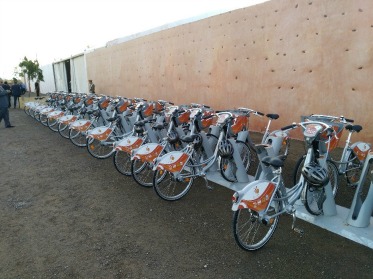
In the spirit of the Paris Agreement, COP22 proposes a “strong vision, light touch”. I was particularly interested in what this meant for China. The National Development and Reform Commission (NDRC), an important governmental body, just released a report titled “China’s policies and actions for addressing climate change – 2016” .
This report mentions that fuel efficiency improved by 15.9% (2005) for private cars and ships and by 13.5% (2016) for the civil aviation sector. A director at the NDRC, whom I interviewed, stressed that this was the result of an emphasis on “green, circular, low-carbon” policies imposed on the private sector within the 12th (2011 -2015) and 13th (2016-2020) five-year plans of the Chinese government. He was also clear on the fact that these policies are being tested and implemented through thousands of projects around China.
In terms of transport modes, I found a clear consensus on acknowledging the benefits of implementing  Bus Rapid Transit systems across populated urban areas. These are dedicated lanes, typically in the center of the road. The increased use of trains and trams were also leading to a consensus between representatives from differing nations, such as Ethiopia and the United States. Smarter forms of using private motorised modes, such as carpooling, car-sharing, on-demand taxis were also seen as potential ways of reducing emissions.
Bus Rapid Transit systems across populated urban areas. These are dedicated lanes, typically in the center of the road. The increased use of trains and trams were also leading to a consensus between representatives from differing nations, such as Ethiopia and the United States. Smarter forms of using private motorised modes, such as carpooling, car-sharing, on-demand taxis were also seen as potential ways of reducing emissions.
Beyond its final results, COP22 was also the opportunity to seal partnerships to spread good practices internationally. Initiatives from official actors and civil society are soaring in an attempt to implement green policies on time. A good example is Mobilise Your City, gathering 100 cities around the world supporting local governments in developing countries to plan and foster sustainable low-carbon urban mobility. A core belief that Mobilise Your City is promoting among its members is that improving mobility is only relevant if there is a net well-being effect.
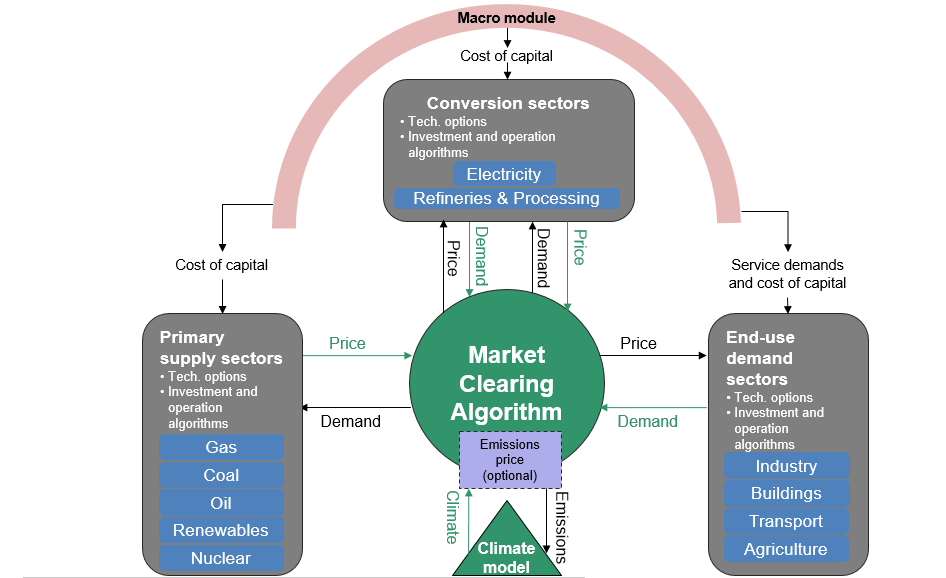 At the start of the year, I was working on the transport module of a new energy systems model developed by researchers at Sustainable Gas Institute (SGI), Imperial College London. The model is called MUSE (Modular Universal energy system Simulation Environment). The aim is that industry will be able to use the model for technology and R&D roadmapping, while it will help international governments make future plans for climate change mitigation.
At the start of the year, I was working on the transport module of a new energy systems model developed by researchers at Sustainable Gas Institute (SGI), Imperial College London. The model is called MUSE (Modular Universal energy system Simulation Environment). The aim is that industry will be able to use the model for technology and R&D roadmapping, while it will help international governments make future plans for climate change mitigation.
MUSE could help answer key COP22 issues. Many participants at COP-22 stressed the lack of research on freight transport, despite the fact that it represents half of overall transport emissions. By taking into account freight-related transportation, MUSE enables us how to assess how policy-makers could avoid unwanted developments, such as a spread of high polluting cars, by looking at the incidence of the price of new technologies based on factors such as economic growth.
Another major opportunity would be to look at the improvement in fuel efficiency of current technologies, such as diesel, petrol and hybrid. Indeed, the share of electric vehicles in the world’s fleet will soar, but fossil fuel powered vehicles will remain an important part of the equation until 2050.
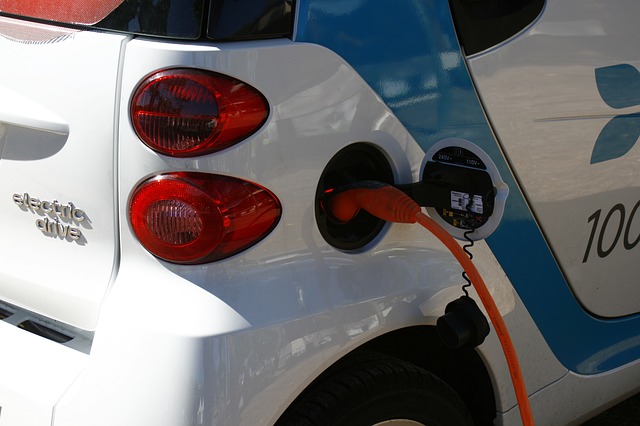 Finally, the MUSE model allows to test such interventions at the national level, which is a relevant scale as powerful policy-makers are often found in capitals. Sanjay Sath, from The Energy and Resources Institute, and Jose Viegas, from the International Transportation Forum expressed the necessity of adopting a dual approach, by implementing national policies at the local level. In that perspective, many highlighted the critical need to get more indicators measuring the progress of environmental policies on the ground to ensure of actual improvement of well-being. An example of such indicators is the proximity of public transport to social housing.
Finally, the MUSE model allows to test such interventions at the national level, which is a relevant scale as powerful policy-makers are often found in capitals. Sanjay Sath, from The Energy and Resources Institute, and Jose Viegas, from the International Transportation Forum expressed the necessity of adopting a dual approach, by implementing national policies at the local level. In that perspective, many highlighted the critical need to get more indicators measuring the progress of environmental policies on the ground to ensure of actual improvement of well-being. An example of such indicators is the proximity of public transport to social housing.
MUSE could make the most of the currently available data in order to give an insight on the future place of transport in urban dynamics, and thus help calculating these indicators further.
You can find out more about MUSE here.
Dr Daniel Crow is a Research Associate at the Sustainable Gas Institute. Daniel’s research is focussed on the mathematical treatment of whole systems approaches to energy modelling.
The good and the great of the international Integrated Assessment Modelling (IAM) community assembled in Potsdam in November for the 8th annual meeting of the IAM consortium. I’m used to attending conferences in slightly off-the-beaten-track places (due, perhaps, to a supposition that relative isolation leads to fewer distractions and a more focused delegation), and this one proved no except ion. Perched on the edge of the Spree, in deep forest, our conference hotel was accessible only by foot along an empty track lit by arching, lonely sodium lamps. A wild boar squealed at me on the first night. It all looked a bit DDR.
ion. Perched on the edge of the Spree, in deep forest, our conference hotel was accessible only by foot along an empty track lit by arching, lonely sodium lamps. A wild boar squealed at me on the first night. It all looked a bit DDR.
Academic matters, however, felt decidedly 21st Century. Main themes included a review of the state-of-the-art in IAM and an evaluation of the potential contributions that Integrated Assessment Models could make in the future. Such models typically integrate the knowledge and methods of different academic disciplines (such as Engineering, Physics and Computer Science) to study complex problems at the nexus of the social, economic, environmental and political sciences, such as Climate Change.
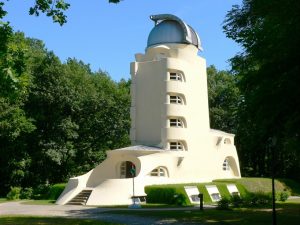
There was much talk of the effictiveness, or not, of Intended Nationally Determined Contributions (INDCs) as a sensible route to implement climate action. Miles Perry (European Commission) pointed out the need for a more “cross-border” approach to emissions targets and, in the run-up to the United Nations COP-21 meeting in Paris, expressed the Commission’s desire to “deliver a robust international agreement” and set “fair and ambitious targets for all countries based on evolving global economic and national circumstances”.
Roberto Schaeffer (COPPE) questioned the “watered-down” tone of the EU’s statement, as well as the continuing focus on mitigation rather than adaptation and resilience. Schaeffer also pointed out that IAMs typically characterise climate mitigation in terms of costs above a business-as-usual scenario, misleadingly failing to include the (potentially much greater) costs of the fall-out from Climate Change: the costs of doing nothing. Perhaps we should all be including an explicit “climate cost” in our objective functions.
The most interesting talks for me were those on uncertainty and the use of IAM projections. James Price (UCL) described a way to explore different future energy scenarios by  relaxing the requirement that the model (in this case UCL-TIAM) minimise the total cost. Most normative models calculate the cheapest way in which a climate constraint (such as a less-than-2°C rise by the year 2100) could be achieved. They show us “idealised” transition pathways that are rarely followed in messy reality. Price’s talk explained how to build up a more realistic picture of future energy systems by exploring “maximally different” scenarios, each of which keeps the total cost low without formally minimising it.
relaxing the requirement that the model (in this case UCL-TIAM) minimise the total cost. Most normative models calculate the cheapest way in which a climate constraint (such as a less-than-2°C rise by the year 2100) could be achieved. They show us “idealised” transition pathways that are rarely followed in messy reality. Price’s talk explained how to build up a more realistic picture of future energy systems by exploring “maximally different” scenarios, each of which keeps the total cost low without formally minimising it.
Such “wiggle-room” might be a way to capture the uncertainties associated with brute optimization. Although the model we are developing at Sustainable Gas Institute (SGI), MUSE, does not rely on minimising system costs, we might yet pursue some of these ideas as a way to improve the plausibility and robustness of MUSE outputs.
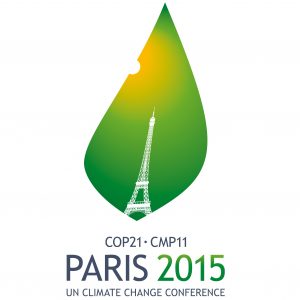 I was struck also by Evelina Trutnevyte’s (ETH) talk on the “impossible mission of embracing parametric and structural uncertainties”. Trutnevyte retro-modelled the UK power system transition between 1990 and 2010 using the bottom-up D-Expanse model and compared her results with what actually happened. Total system costs were around 17% higher than those corresponding to the optimal transition pathway, leading to significantly different transition implications for technology deployment. With a front-row perspective on all the myriad uncertainties that go into an Energy Systems Model, I found myself thinking that missing the mark by only 17% was actually rather impressive.
I was struck also by Evelina Trutnevyte’s (ETH) talk on the “impossible mission of embracing parametric and structural uncertainties”. Trutnevyte retro-modelled the UK power system transition between 1990 and 2010 using the bottom-up D-Expanse model and compared her results with what actually happened. Total system costs were around 17% higher than those corresponding to the optimal transition pathway, leading to significantly different transition implications for technology deployment. With a front-row perspective on all the myriad uncertainties that go into an Energy Systems Model, I found myself thinking that missing the mark by only 17% was actually rather impressive.
The meeting ended with a discussion on future perspectives and opportunities for Integrated Assement Modelling. As the political debate involving “who?”, “what?” and “when?” type questions reaches its climax at COP-21 in Paris, it seems evident that IAMs and Energy Systems Models will play an increasingly influential role in providing a more objective rationale behind internationally agreed actions on mitigation and adaptation.
Our models are emphatically not crystal balls to gaze into the future, but faster computers, more data and better methods should give us more and more confidence in the scenarios they produce, and allow us to quantify the uncertainty inherent in those scenarios.
To find out more about the energy systems model, Daniel and the SGI team are developing, please contact us at SGI@imperial.ac.uk.